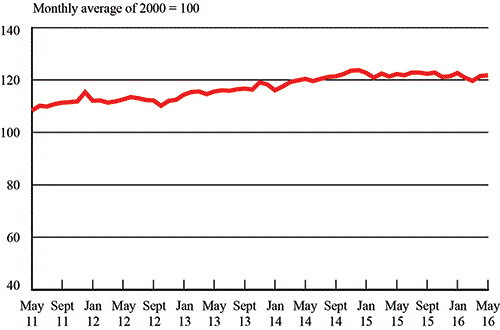Total For-Hire Shipments Rise Despite Trucking Decline
Freight Transportation Services Index, May 2011 - May 2016. Graphic U.S. DOT
" >Freight Transportation Services Index, May 2011 - May 2016. Graphic U.S. DOT
" width="350">A U.S. Transportation Department measure of the amount of freight carried by the nation's for-hire transportation industry rose 0.2% in May from April, the second consecutive monthly gain, and is just 1.5% below the all-time high level hit in December 2014.
In figures released Wednesday, The Freight Transportation Services Index (TSI) moved up to a reading of 121.8, it highest level since January. Also, the April index was revised upward to 121.5 from 121.1 while the March index was revised higher to 119.7 from 119.5 in last month's release.
The combined increase of 1.8% in the Freight TSI from March through May is the largest two-month increase since September to November 2014. Despite this improvement, May for-hire freight shipments are down 0.3% from the same month a year earlier.
The April to May Freight TSI gain was due to growth in all freight modes except trucking and air freight, according to the department.
The increase took place as the Federal Reserve Board's Industrial Production index declined by 0.4% in May, after rising by 0.6% in April. However, personal income, increased by 0.2%, led by personal consumption which increased by 0.4%, while imports of goods increased by 1.9%. Also, overall employment grew, and the ISM Manufacturing Index increased slightly, indicating accelerating manufacturing growth.
The Freight TSI measures the month-to-month changes in freight shipments by mode of transportation in tons and ton-miles, which are combined into one index. The index measures the output of the for-hire freight transportation industry and consists of data from for-hire trucking, rail, inland waterways, pipelines and air freight.
Follow @HDTrucking on Twitter







